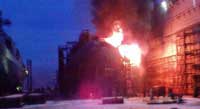 According to the Russian magazine Vlast, “Russia [was] … on the verge of the largest man-made disaster since Chernobyl” when a fire broke out on December 29th, 2011 on the K-84 Ekaterinburg, a Russian nuclear-powered ballistic missile submarine, in a dry-dock in Murmansk. Sparks from welding were reported to have set fire to wooden scaffolding which spread to the rubber acoustic coating on the submarine’s hull. After several hours of fire fighting the sub was partially sunk to control the fire. At the time the damage to the submarine was played down. As reported by the BBC, “The Russian defense ministry said the nuclear reactors on the vessel were already shut down when the fire broke out. All weapons had also been removed from the submarine before it entered the dock, the ministry said.” According to Vlast, however, “K-84 was in the dock with missiles and torpedoes on board.”
According to the Russian magazine Vlast, “Russia [was] … on the verge of the largest man-made disaster since Chernobyl” when a fire broke out on December 29th, 2011 on the K-84 Ekaterinburg, a Russian nuclear-powered ballistic missile submarine, in a dry-dock in Murmansk. Sparks from welding were reported to have set fire to wooden scaffolding which spread to the rubber acoustic coating on the submarine’s hull. After several hours of fire fighting the sub was partially sunk to control the fire. At the time the damage to the submarine was played down. As reported by the BBC, “The Russian defense ministry said the nuclear reactors on the vessel were already shut down when the fire broke out. All weapons had also been removed from the submarine before it entered the dock, the ministry said.” According to Vlast, however, “K-84 was in the dock with missiles and torpedoes on board.”
The standard armament for the submarine is 16 R-29 intercontinental ballistic missiles, each armed with four nuclear warheads. The submarine is also armed with up to 12 torpedoes and anti-submarine missiles, each tipped with either 300 kilograms of high-power military explosive or a nuclear warhead. The submarine is powered by two 90 megawatt water-cooled nuclear reactors each containing about 70 kilograms of uranium-235. Vlast points out that if any of the torpedoes had exploded, it is likely that they could have set off fuel on the ballistic missiles or damaged the nuclear reactors. In the worst case, roughly 400,000 people would have had to have been evacuated from the Kola peninsula, the region around the shipyard.
Submarine was armed with nuclear weapons – magazine
Thanks to Alaric Bond for contributing articles to the post.

If true, management at the shipyard ignored standard safety practices, which are of remove all ammunition from a ship before entering drydock. Short-cutting this practice is a known cause of disasters since German battleship GNEISENAU was drydocked with full magazines during World War II. A bombing hit in February 1942 triggered a magazine explosion that damaged the ship so badly it was never operational again.
My guess is the article was overdrawn and the sub’s tubes were empty. Not to say the fire was a non-event, but the threat of explosion was not as great as the article implied.
It is hard to know who to believe but Vlast is a respected news source and the defense ministry is not know for its candor or veracity.
When the Russians have an industrial accident they almost always go big, and Russian Naval industrial accidents are legendary.
For example, a Russian sailor smoking a cigarette in a restricted area is believed to be the cause of the massive explosions that destroyed Okol’naya – the main ammunition storage base for the Soviet Northern Fleet at Severomorsk on 17 May 1984. For over an hour and a half the accident shot all kinds of flaming missiles all over the surrounding area and threatened to sink at least a pair of Soviet nuclear subs that were tied up at the pier of the ammunition depot at the time. I don’t think they ever controlled that one, so much as let it burn itself out after all the ammunition stored there stopped exploding.
The litany of these massive disasters at the hands of the Russians is almost endless. Adherence to even the simplest of safety precautions seems to be completely beyond their comprehension…..
Pingback: Update: Admiral Confirms Nuclear Submarine Ekaterinburg on Fire was Armed | Old Salt Blog – a virtual port of call for all those who love the sea